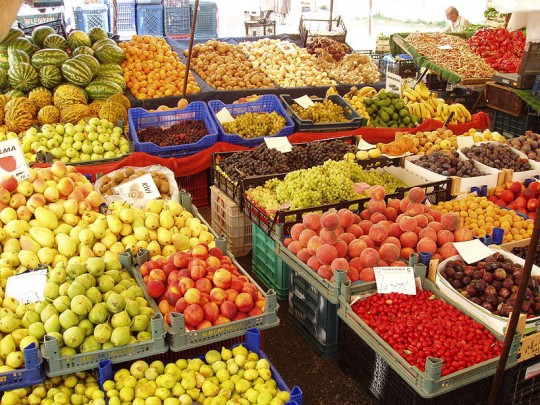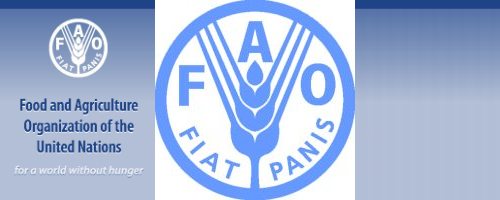Despite end-of-year decline, 2011 food prices highest on record – UN
Despite end-of-year decline, 2011 food prices highest on record – UN
 Photo: NobbiP
Photo: NobbiP
Global food prices declined in December, but the overall annual average was the highest ever on record, the United Nations Food and Agriculture Organization (FAO) reported today.
Last month, FAO’s Food Price Index level was 211 points – 27 points below its peak in February. The decline was driven by sharp falls in the international prices of cereals, sugar and oils due to a productive harvest coupled with a slowing demand and a stronger United States dollar.
However, despite the steady decline in prices during the second half of the year, the Index overall averaged 228 points in 2011 – the highest average since FAO started measuring international food prices in 1990. The second highest average occurred in 2008 at 200 points.
International prices of many food commodities have declined in recent months, but given the uncertainties over the global economy, currency and energy markets, unpredictable prospects lie ahead.
“International prices of many food commodities have declined in recent months, but given the uncertainties over the global economy, currency and energy markets, unpredictable prospects lie ahead,” said FAO Senior Grains Economist Abdolreza Abbassian.
Cereal prices registered the biggest fall due to record crops and an improved supply outlook, with the FAO cereal price index dropping 4.8 per cent last month. Maize prices fell by six per cent, wheat by four per cent, and rice by three per cent. However, the cereal price index for the year rose by 35 per cent from 2010, the highest since the 1970s.
The oils and fats price index also dropped, with a three per cent decline from November due to the unexpected surge in supplies of vegetable oil – mainly of palm and sunflower oil – which, coupled with poor global demand for soybeans, deflated prices.
Meat prices were slightly down from November, mainly due to the 2.2 per cent drop in pig meat prices, but as with other commodities, its annual price was 16 per cent higher than in 2010.
Dairy prices remained almost unchanged, and the sugar price index declined for the fifth consecutive month, reflecting expectations of a large sugar world production surplus over the new season due to good harvests in India, the European Union, Thailand and Russia.
###
FAO Food Price Index ends year with sharp decline
But record high prices mark year as a whole
12 January 2012, Rome – Food prices fell in December 2011 with the FAO Food Price Index dropping 2.4 percent, or five points from November, FAO said today.
At its new level of 211 points, the Index was 11.3 percent (27 points) below its peak in February 2011.
The decline was driven by sharp falls in international prices of cereals, sugar and oils due to bumper 2011 crops coupled with slowing demand and a stronger US dollar. Most commodities were affected.
However, although prices dropped steadily in the second half of 2011, the Index averaged 228 points in 2011 — the highest average since FAO started measuring international food prices in 1990. The previous high was in 2008 at 200 points.
A period of uncertainty
Commenting on the new figures, FAO Senior Grains Economist Abdolreza Abbassian said that it was difficult to make any firm prediction on price trends for the coming months.
“International prices of many food commodities have declined in recent months, but given the uncertainties over the global economy, currency and energy markets, unpredictable prospects lie ahead,” Abbassian said.
Among the principal commodities, cereal prices registered the biggest fall, with the FAO Cereal Price Index dropping 4.8 percent to 218 points in December. Record crops and an improved supply outlook sent prices of major cereals declining significantly. Maize prices fell 6 percent, wheat 4 percent and rice 3 percent. In 2011, the FAO cereal price index averaged 247 points, up some 35 percent from 2010 and the highest since the 1970s.
Oils and fats down
The FAO Oils and Fats Price Index stood at 227 points in December, down 3 percent from November and well below the level of 264 points one year ago. Larger than expected overall supplies of vegetable oil led to a rise in stocks (notably palm and sunflower oil), which, together with poor global demand for soybeans, deflated prices.
The FAO Meat Price Index averaged 179 points, slightly down compared with November. The decline was mainly driven by pig meat, whose price dropped by 2.2 percent, with sheep meat also receding somewhat. By contrast, poultry and bovine meat prices recorded mild gains. On an annual basis, meat prices in 2011 were 16 percent higher than in 2010.
Dairy products mostly up
The FAO Dairy Price Index averaged 202 points, almost unchanged from November. All dairy products were up slightly with the exception of butter, which dropped by 1 percent. Over the whole year, dairy products were on average 10 percent dearer than in 2010, with particularly strong gains witnessed for skim milk powder and casein, which gained 17 percent each. More modest increases were seen for butter and whole milk powder prices, which progressed by 11 percent, and cheese, by 8 percent.
The FAO Sugar Price Index declined for the fifth consecutive month to 327 points in December, down 4 percent from November and 18 percent from its July 2011 peak. The Index’s weakness in recent months mostly reflects expectations of a large world production surplus over the new season, on the back of good harvests in India, the European Union, Thailand and the Russian Federation.
###
> UN Food and Agriculture Organization (FAO).
The Food and Agriculture Organization of the United Nations (FAO) is an intergovernmental organization and has 191 Member Nations, two associate members and one member organization, the European Union. Achieving food security for all is at the heart of FAO’s efforts – to make sure people have regular access to enough high-quality food to lead active, healthy lives.

FAO’s mandate is to raise levels of nutrition, improve agricultural productivity, better the lives of rural populations and contribute to the growth of the world economy.
The Food and Agriculture Organization of the United Nations (FAO) is working with its Members and the entire international community for achievement of the Millennium Development Goals.
These eight goals – each with specific targets and indicators – are based on the United Nations Millennium Declaration, signed by world leaders in September 2000. They commit the international community to combating poverty, hunger, disease, illiteracy, environmental degradation, and discrimination against women.
![]()
The eight Millennium Development Goals are:
Goal 1: Eradicate extreme poverty and hunger
Goal 2: Achieve universal primary education
Goal 3: Promote gender equality and empower women
Goal 4: Reduce child mortality
Goal 5: Improve maternal health
Goal 6: Combat HIV/AIDS, malaria and other diseases
Goal 7: Ensure environmental sustainability
Goal 8: Develop a Global Partnership for Development
* More information at UN Food and Agriculture Organization (FAO)
###
> United Nations (UN).
 The United Nations was established on 24 October 1945 by 51 countries committed to preserving peace through international cooperation and collective security. Today, nearly every nation in the world belongs to the UN: membership totals 192 countries.
The United Nations was established on 24 October 1945 by 51 countries committed to preserving peace through international cooperation and collective security. Today, nearly every nation in the world belongs to the UN: membership totals 192 countries.
When States become Members of the United Nations, they agree to accept the obligations of the UN Charter, an international treaty that sets out basic principles of international relations. According to the Charter, the UN has four purposes:
- to maintain international peace and security;
- to develop friendly relations among nations;
- to cooperate in solving international problems and in promoting respect for human rights;
- and to be a centre for harmonizing the actions of nations.
###
* The above story is adapted from materials provided by United Nations (UN)
** More information at United Nations (UN)




















